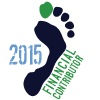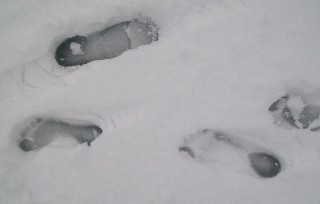
Hey, How Come I Only See Four Toes In That Foot Print?
Made You Look!
Photo Courtesy of Run Barefoot
Winter Barefoot Running ChallengeA Look Into The Antics of A Brave (or Crazy) FewBy Barefooting Bob, with credits to Smelph,Running Barefoot, and Barefoot YOWI was sitting in front of the computer, trying to come up with an opening statement that had that ‘WOW’ factor and then it struck me. This is all about ‘Running Barefoot in the Winter.’ How much more ‘WOW’ can you get than that? This report is all about the curious, but all be it slightly demented few, who like to push the envelope. The ones who get an idea in their head and have to play it out, for better or worse, often started by the innocent question, “I wonder what would happen if I did this?” Sound familiar? Well it does to me, and I am sure to the others whostarted on this journey of enlightenment this winter as well.
This all started innocently enough, a ‘Crazy Canuck Challenge’ was sent out by Alan T and Barefoot YOW of the Canadian Chapter of the BRS in the form of a spread sheet to log barefoot miles completed in below zero (Celsius) temperatures. Me being a ‘Canuck’ and slightly left of center (or at least people tell me), I figured why not, I’m in. So besides myself, 12 other adventurous souls (or 26 bare soles) started on this journey to see where it would take us, how low could we go, and how far.
First, we must list the participants, because without them, this could not of happened, and we would not be able to share the wealth of knowledge that was developed over the course of the winter. In no particular order:
[*]Barefoot YOW (Canada)[*]Run Barefoot (Canada)[*]Smelph (USA)[*]Alan T (Canada)[*]Vanessa Runs (Canada)[*]Barefoot Mary (USA)[*]Inbetweenmytoes (Canada)[*]JamesKulchyk (Canada)[*]Saypay45 (USA)[*]KittyK (Canada)[*]Moomimmamma (Canada)[*]Matt (USA)[*]And myself, Barefooting Bob (Canada)
All should be congratulated for their accomplishments, big or small, because running barefoot in below zero temperatures is not an easy thing to do, and thus I tip my toque to you all (yes another completely Canadian reference).
Now for some stats, starting with the group as a whole than individually with the over achievers.
[*]Total Runs: 118 (120 including the 2 I forgot to log)[*]Total Km: 880.5 km for an average of 7.5 km per run[*]Total Mi: 547.2 mi for an average of 4.63 miles per run[*]Avg. Coldest Temp: -9.8 degrees C (14.36 degrees Fahrenheit)
Run Barefoot (Lou):
[*]Total Runs: 28[*]Total km/mi: 300.7 km/186.8 mi[*]Coldest run: -15.0 degrees C (5 degrees Fahrenheit)[*]Longest Run: 30 km at -8 degrees C (17.6 degree Fahrenheit)
Smelph (Troy):
[*]Total Runs: 25[*]Total km/mi:168.28 km/104.5 mi[*]Coldest Temp: -18.9 degrees C (2.02 degree Fahrenheit)[*]Longest Run: 25.75 km at -7 degrees C (19.4 degree Fahrenheit)
Barefoot YOW (Rod):
[*]Total Runs: 24[*]Total km/mi: 134.6 km/83.63mi[*]Coldest Temp: -19 degrees C (2.2 degree Fahrenheit)[*]Longest Run 18 km at -12 degrees C (10.4 degree Fahrenheit)
Barefooting Bob (That’s me):
[*]Total Runs: 14[*]Total km/mi: 98.6 km/61.1mi[*]Coldest Temp: -29.2 degrees C (20.56 degree Fahrenheit)[*]Longest Run: 20.9 km at -2 degree C (28.4 degree Fahrenheit)
Honourable mentions go to all the other participants listed above who braved mother nature this year to make this little endeavour a success.
Some other fun stats as well:
From Barefooting Bob:
Deepest Snow Travelled: up to my knees.
Set Trail for Hash House Harriers Running Group (Temp was around -20.).
Odd Looks, Finger Pointing and Gasps: Too Many to Count.
Stopped by Police: None but some odd looks once again.
Frost Bite: A couple of minor cases.
Road Salt Burn: Too many; this is what limited my barefoot running.
Lost Toes or Digits: I am proud to say 'NONE.'
Things We Have Discovered Along The Way:
It was amazing to see some of the things that were learned and discovered through our winter running adventures, some are obvious, some not so much, and some were just wow, I never would of guessed that. Here is a list of them that we all feel everybody should know before they attempt Barefoot Winter Running. They are once again in no particular order but all important in their own way:
There is a big difference between cold dry and cold wet running. We would take cold dry over wet any day.Road salt is much worse on your feet than anticipated (again much worse in wet conditions) aside from being generally sharp and painful to step on. A quote from Smelph, “The slush is typically full of road salt. I did a run back in December on sidewalks loaded with the stuff andmy feet felt like they were on fire the whole time (until I started avoiding the sidewalks anyway). So there may be a couple things going on: 1.) It may very well be mild chemical burns, and 2.) Salt breaks down the fibers in stuff like skin and muscle (why it's used as a meat tenderizer), so it may be wreaking havoc on your skin and pads, making them weaker against the road surfaces, stones, more salt, etc.” This was a common experience for a number of our runners including myself.Spring runs are very enjoyable. (-5C and dry; 23 degree Fahrenheit and dry)It is easier to have warm air over the cold ground surface. Running later in the afternoon allowed the sidewalks and pathways to warm up. Radiant heat from the ground surface made longer sub freezing runs possible.Running on snow felt very comfortable, but it drains the heat out of your feet very quickly. We found it commonly takes about 3 km for feet to heat up, so spending some of that time in minimalist shoes can help speed the process. Some people found that 2 km in footwear allowed them to heat up plenty before shedding the shoes. You should tend to aim low 2 km barefoot (1 mile) and if it still feels good, you can keep going from there.Your feet generally begins to generate heat after 3 km, if not, time to throw on the footwear.DO NOT use VFFs as your backup footwear. It is way too difficult to put them on with cold toes. Always, always, alway
s bring some kind of rescue footwear. If your feet get too cold you may not get home again without some warmth.Running in snow (with water shoes) introduced too much stress to your calves. It was great for building foot strength. Something about the way you run in the snow (more forefeet) puts too much strain on your calves. Running in snow reminded both myself and Smelph of running at the beach. It felt like a hell of a workout for the feet, ankles, and calves due to the soft, irregular surface. It's hard work, but it made for some great strength and balance workouts.Gravel bucket running is a great method for removing frost damaged skin.Addition of different products or foods to produce extra heat prior to going running was utilized by a couple of us, including the following: Niacin at the right dose produces a “flush” caused by dilating the small blood vessels in the skin and giving a feeling of warmth and a slight skin flushing. Hot peppers or cayenne pepper helps warm up the body and keeps the blood flowing to the right parts of your body. One misconception that should be noted as well is, the consumption of alcohol is not recommended; this will give you a false sense of security, warming, and will dull your senses to know when you have hit your limit. This being said, there is nothing wrong with a good stiff drink once you are done your adventure.Concrete sidewalks have this uncanny ability to suck the heat out of your feet very quickly. A thin layer of snow (at least for me) seems to work the best for insulating my bare feet.Slush or puddles are not your friend.Try to avoid at all costs. Once your feet get wet, they freeze very quickly, and the core temperature of your feet drops very quickly, inducing frost bite.Running form is very important, and once your feet get cold, it’s very easy to forget this, and you damage your feet quickly from not being able to feel the ground (lots of scrapes, cuts, and stubbed toes).Wind-chill is not your friend either; it can be very deceiving with a decent base temperature and a high wind-chill. The top of your feet get cold quickly which results in a downward effect and loss of feeling in your feet.Layer your clothing so that you're a little bit hotter than you think you should be while running. Experiment and figure out what works best for you, as there may be a point where more layers won't do you any good (this is from personal experience). A good hat and pair of gloves are pretty much mandatory.One point that I discovered as well was, keeping my ankles warm by covering them with either wristbands or headbands (I used some knitted wool headbands doubled up-brown and purple quite the fashion statement.) seemed to make my feet warmer.You can let your feet get cold and even uncomfortable, but when they start to feel real pain; don’t push it any farther barefoot. I have realized that the risk of frostbite while running barefoot has more to do with the surface temperature than the air temperature or wind chill.Let your feet heal completely prior to going out again. If you do not, this could lead to permanent damage, and nobody wants that.But the most important thing to remember is listen to your body. You have to know how far you can go, and the onset of any pain means you should stop and call it a day. No challenge is worth damaging your feet or possibly losing a toe.I have to end the advice with the quote by Stomper from The BRS Oregon Chapter, it still makes me laugh when I see it: “Not many tricks left here to try, maybe fuzzy pink rabbit slippers with the bottoms cut out?”
Overall, it was a great experience for me, and I hope that all other participants enjoyed it as much as I did. It was interesting to see how far you could push the limits, and the looks and comments were very interesting as well.
Until next winter season, to see if the boundaries can be pushed just a little farther.
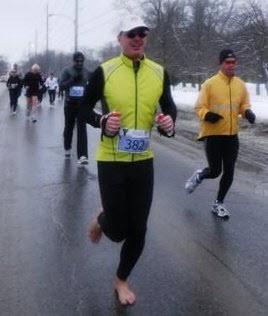
Lou Rantin running in half marathon in Canada, February 2011
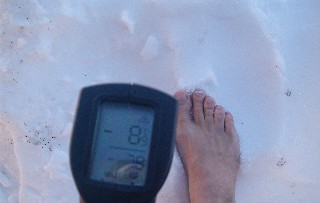
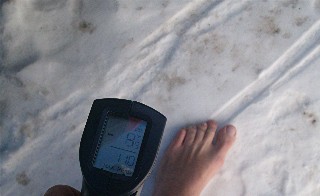
Run Barefoot Checking The Ground Temp
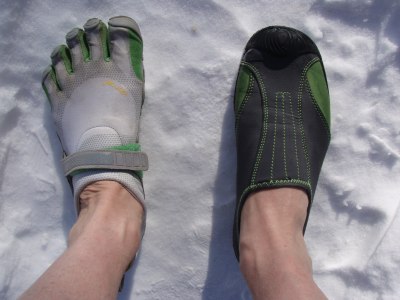
Barefoot YOW's winter running footwear choices
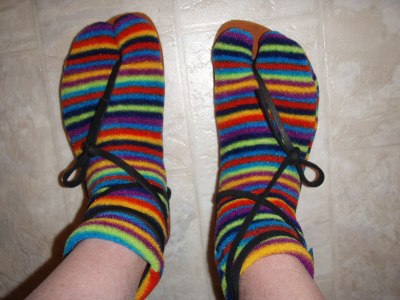
Fleece TabiSocks with Luna Sandals
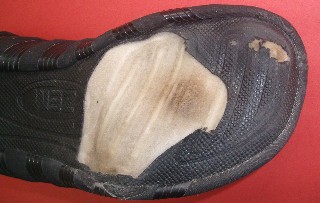
Web ripped ZEMs











